【中考复习】 中考英语专题复习阅读理解教案
- 格式:doc
- 大小:88.50 KB
- 文档页数:6
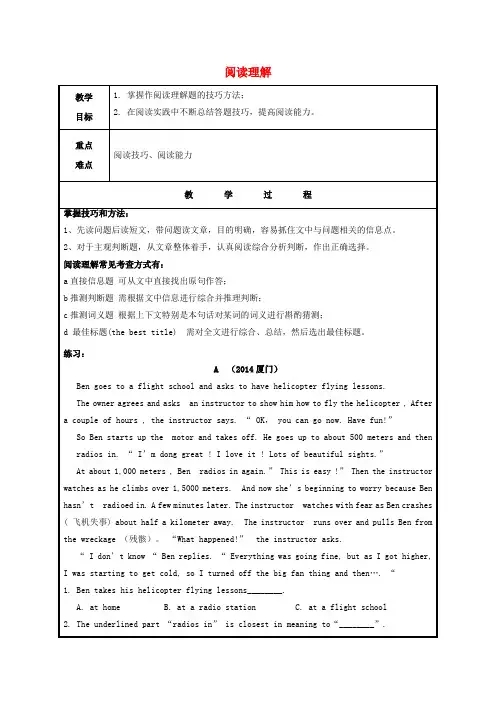
阅读理解A.communicates with someone by radio B.puts the radio inside C. turns on the radio3. At a height of about _______ meters, the instructor is starting to worry about Ben.A. 500B. 1,000C. 1,5004. According to the passage, we know that Ben _______.A. was killed in the crash about half a kilometer awayB. was doing fine with the flying at different heightsC. was feeling cold on the helicopter before the crash5. The possible reason for the crash is that Ben _______.A. shut off the big fan thing on the helicopterB. refused to talk with the instructorC. kept radioing in on the helicopterB(2014呼和浩特)Our village carpenter (木匠) , John, came one day and made a dining table for my wife.He made it just the right size for the space between the two windows.When I got home that evening, John was drinking a cup of tea and writing out his bill for the job.My wife said to me quietly,“That’s his ninth cup of tea today.”But she said, in a loud voice,“It’s a beautiful table, dear, isn’t it?”“I’ll decide about that when I see the bill.”I said.John laughed and gave me his bill for the work.I read:One dining table 10 November, 1998Cost of wood $17.00Paint $1.50Work, 8 hours ( $1 an hour ) $8.00Total $36.50When I was looking at the bill, John said, “It’s been a nice day, hasn’t it?Quite sunny.”“Yes.”I said.“I’m glad it’s only the tenth of November.”“Me, too.”said John.“You wait —it’ll be a lot colder by the end of the month.”“Yes,colder — and more expensive! A dining table will be $20 more expensive on November 30, won’t it, John?”John looked hard at me for half a minute.Was there a little smile in his two blue eyes?I gave his bill back to him.“If there isn’t too much trouble, John,” I said,“please add it up again.You can forget the date…”I paid him $26.50 and he was happy to get it.1.Why did John talk about the weather when the writer was looking at the bill?A.Because he didn’t want the writer to go through the bill carefully.B.Because it was really a fine day.C.Because he wanted the writer to check the bill carefully.D.Because he wanted to tell the writer what the weather was like.2. The writer thought John would ask for _______ if he made a dining table on the last day of November.A.$20.00 B.$46.50 C.$56.5 D.$26.503.When the writer gave John the money, he was happy because _______.A.he got what he should get for his workB.he got much more money for his workC.he got the money easilyD.he didn’t have to add up the cos ts again4.From the story we know that ______.A.John made a mistake in the billB.John tried to fool the writer in order to get more money for his workC.John had written out the bill before the writer got homeD.John still wanted to get $36.50 for his work in the end5.What do you think of the writer? He is ______.A.honest B.clever C.foolish D.afraidC(2014 南京)More than anything else in the world, Lion liked being King of the jungle. He walked around, showing off his power and pride.Each day Lion took a long lazy sleep under the shade of his favourite tree. Healways dreamed of weaker animals bowing(鞠躬) before him.One day Mouse ran through the jungle and tripped over Lion’s huge paws. Lion woke up with a start. “How dare you wake me up! ” he shouted angrily. Lion grabbed Mouse with one paw. “On the second thought, I’m in the mood for the snack, and you’ll make a delicious meal.”, he said.Mouse cried out, “King Lion, please spare(饶恕)me! If you let me live, I’ll always remember your kind ness. And, some day, I might be able to help you.”“ How could such a powerless little mouse ever help me?” That thought made Lion laugh so much that he decided to let Mouse go. A week later, Lion was walking through the jungle on the way to his favourit e tree when he stepped onto a hunter’s net. The net scooped him up. No matter how he twisted and turned, he couldn’t escape.When Mouse heard Lion’s frightened shouts, he raced to help. Mouse quickly chewed (咬)through the ropes to make a hole in the net. Soon, Lion moved out and was free. Lion looked down at the little mouse. “Thank you for saving my life,” said Lion, smiling his widest smile. “I was mistaken. You are not a powerless little mouse. You area great friend!”1. What did Lion do each day?A. He stepped onto a hunter’s net.B. He bowed before weaker animals.C. He showed kindness to animals in the jungle.D. He had a good sleep under his favourite tree.2. How did Mouse wake up Lion?A. He made a hole in the net.B. He shouted at Lion angrily.C. He tripped over Lion’s paws.D. He prepared a delicious meal for Lion.3. Why did Lion let Mouse go?A. Because he was trapped in the net.B. Because he took Mouse as his good friend.C. Because he believed Mouse could save him.D. Because he doubted if Mouse could be of any help.4. What do you think of Mouse?A. Clever and honest.B. Silly and lazyC. Humorous and stubbornD. Proud and selfish.5. What can we learn from the passage?A. Pride makes you lose what you have.B. Don’t put all your eggs in one basket.C. Even the small can show great strength.D. When the cat’s away, the mice will play.1. 整理笔记2.完成《考易通》教学反思:。

中考英语专题复习阅读理解教案狗可以给盲人带来信心,因为它们有闪亮的棕色眼睛和无条件的帮助。
Tip2:①注意上下文中的词汇和语境。
②根据前后文推断词义。
三)Reading strategies1.预览:大致浏览文章,了解主题和结构。
2.细读:仔细阅读,注意细节和关键词。
3.归纳:总结文章的中心思想和重要细节。
4.推理:根据文章内容进行推理和判断。
四)PracticeLet’s practice the strategies with some exercises.四、作业布置1.阅读理解练册P105-P1092.预下一课时内容:写作技巧Homework:plete the reading n exercises on P105-P109.2.Preview the next lesson: Writing skills.文章中有格式错误和明显问题的段落已被删除,以下是改写后的文章:Prefixes like un。
ir。
dis。
im can change the meaning of a word。
For example。
the prefix un can mean "not" or "the opposite of." So。
unhappy means "not happy," and unfair means "not fair." If a word starts with ir。
it usually means "not," like irregular meaning "not regular." Dis means "not" or "the opposite of," like disagree meaning "not agreeing." Finally。
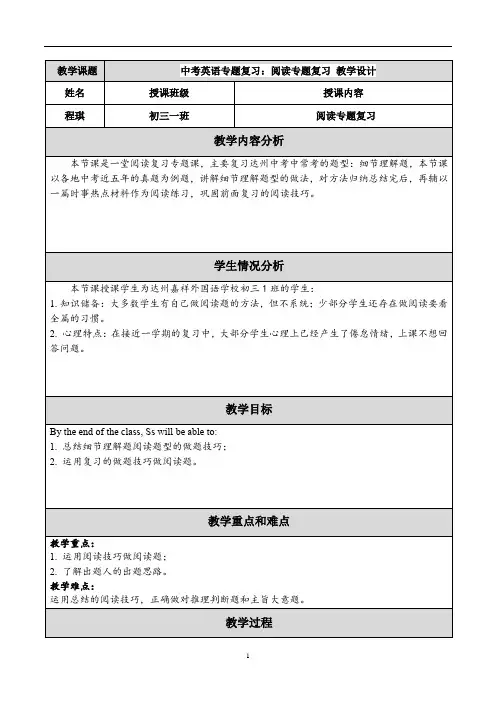
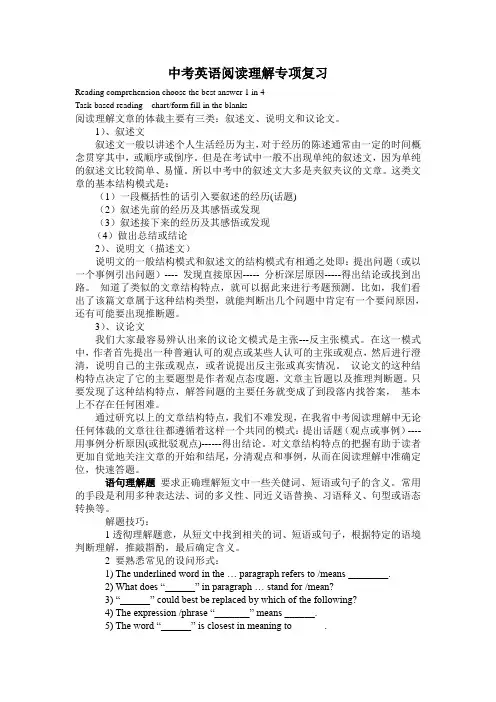
中考英语阅读理解专项复习Reading comprehension choose the best answer 1 in 4Task-based reading chart/form fill in the blanks阅读理解文章的体裁主要有三类:叙述文、说明文和议论文。
1)、叙述文叙述文一般以讲述个人生活经历为主,对于经历的陈述通常由一定的时间概念贯穿其中,或顺序或倒序。
但是在考试中一般不出现单纯的叙述文,因为单纯的叙述文比较简单、易懂。
所以中考中的叙述文大多是夹叙夹议的文章。
这类文章的基本结构模式是:(1)一段概括性的话引入要叙述的经历(话题)(2)叙述先前的经历及其感悟或发现(3)叙述接下来的经历及其感悟或发现(4)做出总结或结论2)、说明文(描述文)说明文的一般结构模式和叙述文的结构模式有相通之处即:提出问题(或以一个事例引出问题)---- 发现直接原因----- 分析深层原因-----得出结论或找到出路。
知道了类似的文章结构特点,就可以据此来进行考题预测。
比如,我们看出了该篇文章属于这种结构类型,就能判断出几个问题中肯定有一个要问原因,还有可能要出现推断题。
3)、议论文我们大家最容易辨认出来的议论文模式是主张---反主张模式。
在这一模式中,作者首先提出一种普遍认可的观点或某些人认可的主张或观点,然后进行澄清,说明自己的主张或观点,或者说提出反主张或真实情况。
议论文的这种结构特点决定了它的主要题型是作者观点态度题,文章主旨题以及推理判断题。
只要发现了这种结构特点,解答问题的主要任务就变成了到段落内找答案,基本上不存在任何困难。
通过研究以上的文章结构特点,我们不难发现,在我省中考阅读理解中无论任何体裁的文章往往都遵循着这样一个共同的模式:提出话题(观点或事例)---- 用事例分析原因(或批驳观点)------得出结论。
对文章结构特点的把握有助于读者更加自觉地关注文章的开始和结尾,分清观点和事例,从而在阅读理解中准确定位,快速答题。

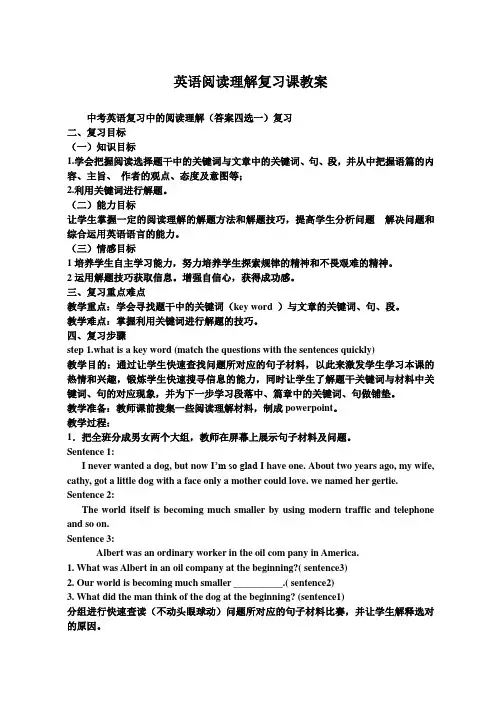
英语阅读理解复习课教案中考英语复习中的阅读理解(答案四选一)复习二、复习目标(一)知识目标1.学会把握阅读选择题干中的关键词与文章中的关键词、句、段,并从中把握语篇的内容、主旨、作者的观点、态度及意图等;2.利用关键词进行解题。
(二)能力目标让学生掌握一定的阅读理解的解题方法和解题技巧,提高学生分析问题解决问题和综合运用英语语言的能力。
(三)情感目标1培养学生自主学习能力,努力培养学生探索规律的精神和不畏艰难的精神。
2运用解题技巧获取信息。
增强自信心,获得成功感。
三、复习重点难点教学重点:学会寻找题干中的关键词(key word )与文章的关键词、句、段。
教学难点:掌握利用关键词进行解题的技巧。
四、复习步骤step 1.what is a key word (match the questions with the sentences quickly)教学目的:通过让学生快速查找问题所对应的句子材料,以此来激发学生学习本课的热情和兴趣,锻炼学生快速搜寻信息的能力,同时让学生了解题干关键词与材料中关键词、句的对应现象,并为下一步学习段落中、篇章中的关键词、句做铺垫。
教学准备:教师课前搜集一些阅读理解材料,制成powerpoint。
教学过程:1.把全班分成男女两个大组,教师在屏幕上展示句子材料及问题。
Sentence 1:I never wanted a dog, but now I’m so glad I have one. About two years ago, my wife, cathy, got a little dog with a face only a mother could love. we named her gertie. Sentence 2:The world itself is becoming much smaller by using modern traffic and telephone and so on.Sentence 3:Albert was an ordinary worker in the oil com pany in America.1. What was Albert in an oil company at the beginning?( sentence3)2. Our world is becoming much smaller __________.( sentence2)3. What did the man think of the dog at the beginning? (sentence1)分组进行快速查读(不动头眼球动)问题所对应的句子材料比赛,并让学生解释选对的原因。
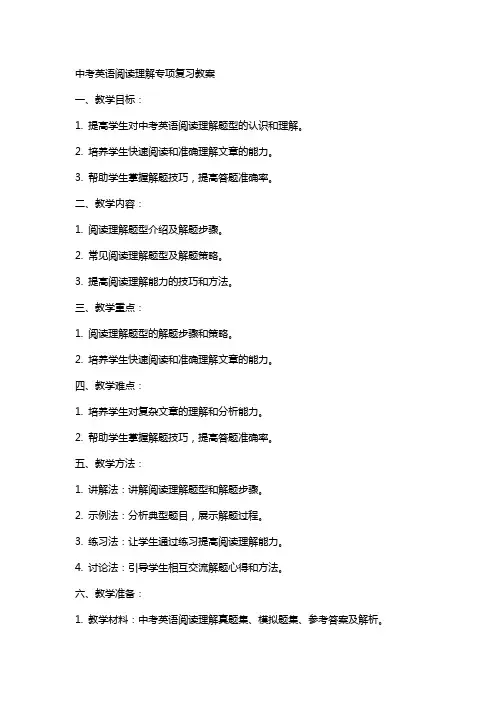
中考英语阅读理解专项复习教案一、教学目标:1. 提高学生对中考英语阅读理解题型的认识和理解。
2. 培养学生快速阅读和准确理解文章的能力。
3. 帮助学生掌握解题技巧,提高答题准确率。
二、教学内容:1. 阅读理解题型介绍及解题步骤。
2. 常见阅读理解题型及解题策略。
3. 提高阅读理解能力的技巧和方法。
三、教学重点:1. 阅读理解题型的解题步骤和策略。
2. 培养学生快速阅读和准确理解文章的能力。
四、教学难点:1. 培养学生对复杂文章的理解和分析能力。
2. 帮助学生掌握解题技巧,提高答题准确率。
五、教学方法:1. 讲解法:讲解阅读理解题型和解题步骤。
2. 示例法:分析典型题目,展示解题过程。
3. 练习法:让学生通过练习提高阅读理解能力。
4. 讨论法:引导学生相互交流解题心得和方法。
六、教学准备:1. 教学材料:中考英语阅读理解真题集、模拟题集、参考答案及解析。
2. 教学工具:投影仪、电脑、黑板、粉笔。
七、教学过程:1. 课堂导入:简要介绍中考英语阅读理解题型及重要性。
2. 新课内容:讲解阅读理解题型和解题步骤,分析典型题目。
3. 课堂练习:让学生进行阅读理解练习,教师即时批改并给予反馈。
4. 总结讲解:针对学生练习中出现的问题,讲解解题技巧和方法。
八、课后作业:1. 让学生完成一定数量的阅读理解练习题。
2. 要求学生总结解题心得和方法,并在下一节课分享。
九、教学评价:1. 课堂表现:观察学生在课堂上的参与度和积极性。
2. 练习成果:评估学生在课后作业中的表现,对答题准确率进行统计。
3. 学生反馈:收集学生对教学内容的意见和建议,以便进行调整和改进。
十、教学反思:1. 总结课堂教学的优点和不足。
2. 根据学生反馈和教学评价,调整教学方法和内容。
3. 制定后续教学计划,确保学生在中考英语阅读理解方面取得优异成绩。
重点和难点解析一、教学目标:在制定教学目标时,应关注如何使学生明确中考英语阅读理解的重要性,并设定具体可衡量的发展目标,如提高学生的阅读速度、理解深度和答题技巧。

26阅读理解(二)【教学目标】让学生熟知问答式阅读理解题型,了解问答式阅读理解命题目的,掌握问答式阅读理解答题技巧。
【重点难点】让学生掌握问答式阅读理解解题技巧和步骤,提高做问答式阅读理解题目的能力。
【命题目的】问答式阅读理解题主要是考查学生通过阅读获取信息、分析信息和处理信息的能力,既要抓住文章的主旨,又要抓住细节;既要理解具体事实,又要理解抽象概念;既要理解文章字面意思,又要挖掘意图,揣摩隐藏在字里行间的内涵;既要理解全篇的逻辑关系,又要理解某些细节的意思,并且在读懂句子和文章的基础上,将所读文章进行判断、分析和推理。
对问答式阅读理解的考查主要集中在以下两个方面:1. 能获取文章的具体信息。
2. 能理解归纳文章的主旨要义。
【真题例析】阅读下面的材料,然后根据材料内容回答问题。
The World Wide Web(www.万维网)turned 25 year s old on March 12th. It has become a very important partin our daily lives. We can’t i magine living without the web, the short form of the World Wide Web.In 1989, a British engineer named Tim Berners-Lee came up with the idea of the Web. It is a group of “pages” of information that are connected to each other around the world. That is the very beginning of the We b. Since then, the Web has greatly changed the way people live. With a click(点击)of a mouse we can read news, buy things, make friends and learn anything we’re interested in.Now, 25 years after its birth, how will the Web influence life in the future? Scientists believe there are both advantages and disadvantages.A growing Web will help build “better relationships” between different cul tures. Also in the future, everyday items could be connect ed to the Web. We could share plenty ofinformation to make our daily lives more convenient(方便的). S o one day in the future, your front door could send you a message. “Dear sir, everyone has left the house, but I’ m still open!”But scientists warn(警告)us that if we share personal information on the Inte rnet it could get into the wrong hands.“It’s not wise to spend a whole day in front of the screen. People need to get close to nature and enjoy the sun. Never be controlled by the Internet.” said Berners-Lee.1.How old is the World Wide Web?2.Who came up with the idea of the Web?3.What can we do by clicking a mouse according to the passage?4.Will the Web influence life in the future?5.What could happen if we share personal information on the Internet?参考答案:1. 25 years old.2. Tim Berners-Lee.3. We can read news, buy things, make frien ds and learn anything we’re interested in.4. Yes, it will.5. Our personal information will be made use of【答题技巧】答题步骤:1. 初读文章,标好段落。
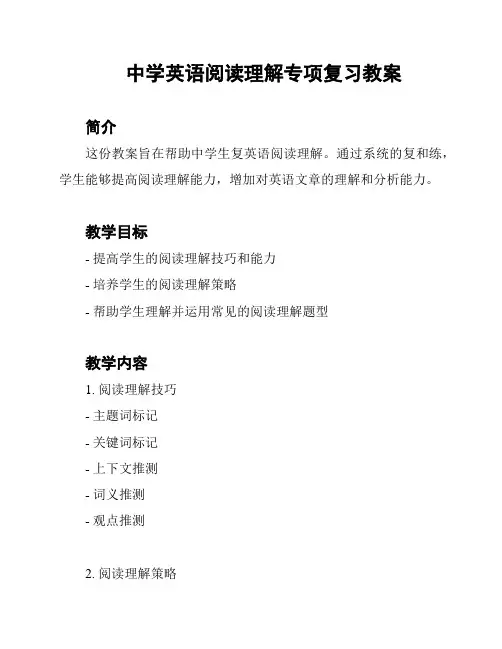
中学英语阅读理解专项复习教案简介这份教案旨在帮助中学生复英语阅读理解。
通过系统的复和练,学生能够提高阅读理解能力,增加对英语文章的理解和分析能力。
教学目标- 提高学生的阅读理解技巧和能力- 培养学生的阅读理解策略- 帮助学生理解并运用常见的阅读理解题型教学内容1. 阅读理解技巧- 主题词标记- 关键词标记- 上下文推测- 词义推测- 观点推测2. 阅读理解策略- 快速浏览文章,了解大意- 高效阅读,找出关键信息- 理解作者观点,分析文章结构- 掌握问题解答技巧,尤其是排除法3. 阅读理解题型- 判断正误题- 选择题- 完形填空- 阅读推断题教学方法1. 整体导入法:通过引入感兴趣的话题或故事,激发学生的阅读兴趣和动力。
2. 分析法:针对不同的题型,进行分析和讲解相关的解题技巧,帮助学生理解题意。
3. 练与训练:提供大量的阅读理解练题,让学生通过实际操作巩固所学知识和技巧。
4. 反馈与讨论:对学生的答案进行及时反馈和讨论,帮助学生发现和纠正错误,提高对题目的理解和思考能力。
教学评估1. 阅读理解作业:布置一定数量的阅读理解题目,学生独立完成并提交答案。
2. 小组讨论:组织学生进行小组讨论,分享解题思路和答案,并互相评价和给予建议。
3. 个别辅导:针对提供错题辅导,对学生进行个别指导和补充练,帮助他们进一步提高。
计划安排- 第一周:阅读理解技巧讲解和练- 第二周:阅读理解策略讲解和练- 第三周:阅读理解题型讲解和练- 第四周:教学评估和复总结教学资源- 中学英语教材或相关教辅- 阅读理解练题集- 网络资源和多媒体设备结束语通过本教案的实施,相信学生们会在英语阅读理解方面取得显著进步。
请学生们积极参与,勤加练习,相信你们一定能够取得优异的成绩!。
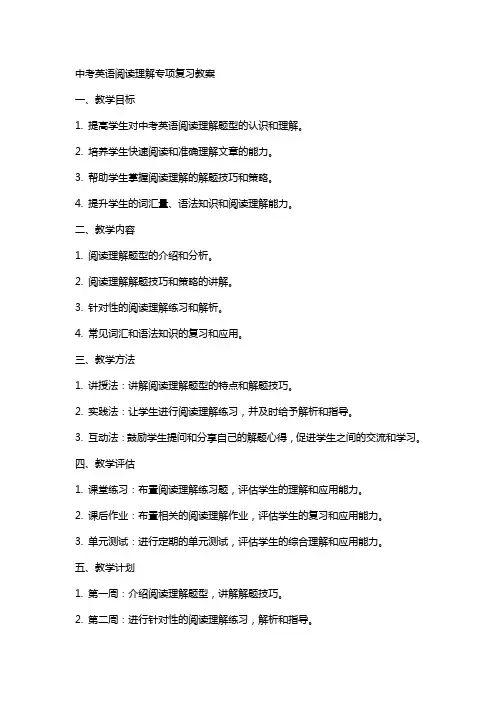
中考英语阅读理解专项复习教案一、教学目标1. 提高学生对中考英语阅读理解题型的认识和理解。
2. 培养学生快速阅读和准确理解文章的能力。
3. 帮助学生掌握阅读理解的解题技巧和策略。
4. 提升学生的词汇量、语法知识和阅读理解能力。
二、教学内容1. 阅读理解题型的介绍和分析。
2. 阅读理解解题技巧和策略的讲解。
3. 针对性的阅读理解练习和解析。
4. 常见词汇和语法知识的复习和应用。
三、教学方法1. 讲授法:讲解阅读理解题型的特点和解题技巧。
2. 实践法:让学生进行阅读理解练习,并及时给予解析和指导。
3. 互动法:鼓励学生提问和分享自己的解题心得,促进学生之间的交流和学习。
四、教学评估1. 课堂练习:布置阅读理解练习题,评估学生的理解和应用能力。
2. 课后作业:布置相关的阅读理解作业,评估学生的复习和应用能力。
3. 单元测试:进行定期的单元测试,评估学生的综合理解和应用能力。
五、教学计划1. 第一周:介绍阅读理解题型,讲解解题技巧。
2. 第二周:进行针对性的阅读理解练习,解析和指导。
3. 第三周:复习相关词汇和语法知识,进行应用练习。
4. 第四周:进行单元测试,评估学生的理解和应用能力。
5. 第五周:针对学生的弱点进行复习和强化训练。
六、教学资源1. 教材:中考英语阅读理解专项复习教材。
2. 辅助材料:相关阅读理解练习题和答案解析。
3. 多媒体设备:电脑、投影仪等,用于展示教材和辅助教学。
4. 网络资源:查找相关的阅读理解练习题和答案解析,以便进行拓展训练。
七、教学进程1. 课前准备:教师提前准备好教材、辅助材料和教学设备。
2. 课堂讲解:教师根据教案进行讲解,引导学生理解和掌握阅读理解的解题技巧。
3. 课堂练习:教师布置针对性的阅读理解练习题,学生进行练习,教师及时给予解析和指导。
4. 课后作业:教师布置相关的阅读理解作业,学生进行复习和巩固。
5. 单元测试:教师进行定期的单元测试,评估学生的综合理解和应用能力。

阅读理解一、教学目标:掌握阅读技巧、了解中考阅读理解题型、提高阅读能力二、导入Questionnaire1.Do you have great difficulty finishing reading comprehension in the exam?Why?2. Read Passage4&5&7&8 On Page105-109and find out which kinds of questions you feel difficult to answer.Find detailed information?Give the main idea? Find the topic sentence?Guess the meaning of the word?Do you want to do all the questions in reading comprehension correctly?If you want to succeed, please follow me.三、课堂研讨(一)The main question patterns1.The Fact Question(查找事实、细节型)2.Words in the Context (猜测词义型)3.The Inference Question(判断推理型)4.The Title/Main idea Question(概括主旨大意型)(二)In what way can we work out the meaning of new words?1.构词法2.、3、近、反义词4、根据上下文判断词意①Is it difficult for you to get up in the morning? Do you sometimes oversleep? 合成词:睡过头over=too muchovercrowded, overwork…Tip1:①根据合成词中的已知词含义进行整合,②放入语境中进行猜测。
中考英语专题复习:阅读专题复习教学设计教学目标:1. 了解中考英语阅读专题的考点和题型2. 掌握解题技巧和策略3. 提高学生的阅读理解能力和应试能力教学内容:1. 阅读题型概述1.1 阅读理解题:短文理解、信息匹配、推理判断等1.2 完形填空题:补全短文、语法填空等2. 阅读理解解题技巧2.1 快速浏览短文,了解文章大意2.2 注意关键词和信号词,帮助定位和理解2.3 留意上下文的提示和线索2.4 根据问题要求选择合适的解题方式3. 完形填空解题策略3.1 全局把握,掌握文章整体脉络3.2 分析句子结构,理解上下文逻辑关系3.3 根据语境和语法规则,选择合适的词语填空教学步骤:一、导入新知为了激发学生的学习兴趣和主动性,可以通过设置开放式问题或给出一段引人入胜的短文引导学生进入主题,如一篇关于环保的报道。
二、介绍考点和题型通过展示中考英语阅读题的样例和解析,让学生了解到中考英语阅读题的特点和难点,引导学生对考点有初步认识。
三、进行阅读题解析1. 阅读理解题解析根据选取的一篇适合中考题型的短文,以课堂讨论的方式进行解析,引导学生掌握解题技巧和策略。
2. 完形填空题解析选取一篇适合中考题型的完形填空短文,通过详细解析其中的关键句和重要词汇,让学生理解解题技巧和策略。
四、巩固练习根据学生的阅读理解能力和考试准备程度,设计一些有针对性的练习题,通过个人、小组或全班形式进行练习,鼓励学生运用所学知识解题。
五、拓展延伸提供一些额外的阅读材料,让学生自主阅读,并设计一些开放性的问题,引导学生进一步思考和拓展知识。
六、总结反思与学生一起总结本堂课的学习成果和收获,让学生分享解题经验和策略,鼓励学生交流和互助。
七、布置作业根据学生的学习情况,布置一些适当的作业,巩固所学知识和技巧。
作业可以包括练习题、阅读材料或写作练习。
八、教学反思回顾整堂课的教学过程,分析学生的学习情况和表现,及时调整教学策略和方法,为后续教学做好准备。
初中英语阅读理解教案一、教学目标1. 学生能够读懂长难句,了解上下文语境,理解文章意思。
2. 学生能够通过阅读理解文章,准确回答问题。
3. 学生能够通过阅读理解文章对于英语语言知识的提高和语感培养具有重要意义。
二、教学重点1. 学生通过阅读理解文章,提高英语语言知识的掌握和语感的培养。
2. 学生通过分析上下文语境,理解长难句的含义,满足理解文章的要求。
三、教学难点1. 学生需要在较短的时间内能够对于完整的文章进行阅读理解学习。
2. 学生需要具备较强的语感和翻译能力,理解大量的英语语言知识。
四、教学过程1. 导入对于学生的知识水平和学习评估,通过口语测试和写作测试等方法进行测评。
同时,对于教学资料和教学方法进行评估,为教学打下基础。
2. 阅读理解题目在阅读理解中,将文章分成两个部分,一部分是文章本身,另一部分是问题解答。
教师需要直接给学生提问,让学生能够根据问题的需求来分析文章的语言含义,实现对于文章的理解。
同时,学生需要通过对于问题的回答,来回顾和巩固对于文章的理解。
3. 讲解语言知识在阅读理解中,语言知识是非常重要的。
教师需要通过教材和一些经典的例子来讲解英语语言的语法规律,动词时态规则以及词汇的应用方法。
通过讲解,学生能够更好的理解语言知识,满足学生的英语语言知识的提高要求。
4. 练习教师需要通过练习来巩固学生的阅读理解能力和语言应用能力。
需要通过多种练习方法,例如英语语言游戏、互动环节等方式来实现学生的英语语言应用和交流。
同时,教师需要根据学生的不同情况,及时给学生反馈,让学生能够自我检查和自我完善。
五、教学效果通过教师的指导和学生的不断学习,学生能够更好的理解和应用英语语言知识。
同时,学生的阅读能力得到了进一步提高和巩固。
学生也能够根据不同的情况,使用更好的英语语言学术知识进行交流和思考。
初三年级英语复习教案(一):阅读理解和写作练习。
一、阅读理解阅读理解是英语学习中非常重要的一项能力,而阅读理解的提高需要大量的阅读量和逐渐的积累。
本教案提供以下阅读理解练习,帮助学生培养自己的阅读理解能力。
1.The Lost HatKerry was walking to the park with her friends when a gust of wind blew her hat away. She watched as the hat went higher and higher until she couldn't see it anymore.Kerry was very upset. She loved that hat and it was her favorite. Her friends tried to cheer her up, but it didn't work. Kerry decided to go and look for her hat.She searched around the park and found many hats, but none of them were hers. As she was about to give up, a little girl asked her what was wrong. Kerry told the girl about her lost hat.The girl smiled and said, "Wait here, I'll be back in a minute." A few minutes later, the girl returned with Kerry's hat.Kerry was so happy that she hugged the girl. She thanked her and asked her how she found the hat. The girl said that she had seen it fly away and followed it until it landed in a tree. She climbed the tree and got the hat for Kerry.Kerry was overjoyed to have her hat back. She thanked the little girl again and learned an important lesson that day. She learned that kindness can be found in even the smallestof people.Questions:1.Where was Kerry going when her hat blew away?2.Why was Kerry so upset when her hat blew away?3.Did Kerry find her hat around the park?4.Who brought Kerry her lost hat?5.What lesson did Kerry learn from her experience?6.Reducing Plastic WastePlastic waste is a growing problem around the world. Every day, millions of plastic bottles, bags and otherproducts are used and thrown away. This waste ends up in our oceans and landfills, causing harm to our environment.One way to reduce plastic waste is by using less plastic. We can do this by using reusable bags and water bottles, and by saying no to plastic straws, cups and utensils.We can also recycle plastic items properly. Many cities and towns have curbside recycling programs that allow residents to place plastic items in their recycling bins.It's important to check with your local recycling center about what types of plastics they accept.Another way to reduce plastic waste is by supporting businesses that use sustainable practices. Many companies are now using biodegradable or compostable plastics, which break down naturally in the environment.It's up to each of us to do our part in reducing plastic waste. By making small changes in our daily lives, we can help protect our planet for future generations.Questions:1.What is plastic waste?2.How does plastic waste harm the environment?3.How can we reduce plastic waste by using lessplastic?4.How can we properly recycle plastic items?5.How can we support businesses that use sustainablepractices?二、写作练习写作能力是英语学习中的另一项重要能力,而写作能力的提升需要大量的练习和积累。
初中英语教案主要复习阅读理解在初中阶段,英语课程的教学重点逐渐从基础知识的学习转变为语言运用能力的培养。
而阅读理解则是其中非常重要的一环。
学生通过阅读,不仅可以增加词汇量、提高阅读速度和表达能力,还可以获得其他方面的信息。
因此,在教学过程中,教师需要将阅读理解作为主题之一,进行有针对性的复习。
一、基础知识复习在进行阅读理解训练之前,先需要对一些基础知识进行复习。
首先是词汇量的扩充。
教师可以根据课本和其他教材,选择到学生水平的词汇进行讲解和练习。
其次是语法知识的巩固。
语法知识对于学生的语言运用能力有着非常重要的影响。
有时候,学生在阅读中遇到难度,可能是因为不理解某些语法规则而导致的。
因此,在教学中,教师还需要对一些语法知识进行温故知新。
二、阅读素材准备教师需要根据学生的实际情况,选取适合学生水平的阅读素材。
其中既包括课本中的阅读材料,也包括其他教材和公开材料。
教师可以为学生供给多样化的阅读素材,包括新闻报道、科技信息、文学作品以及历史事件等等。
这样可以帮助学生养成良好的阅读习惯,提高其语言运用能力和综合思维能力。
三、阅读理解技巧指导在学生阅读素材的过程中,教师需要引导学生学习阅读理解的具体技巧。
这些技巧包括阅读理解题的类型和解题方法。
例如,让学生学习如何针对具体问题复杂型的题型,如如何判断阅读素材的作者观点、如何识别出文章中的文意和象征性语言。
教师还需要让学生学习如何通过图表等非文本方式理解文章内。
四、阅读理解训练在基础知识复习、阅读素材准备、阅读理解技巧指导等准备工作后,教师需要让学生进行具体的阅读理解训练。
教师可以选择合适的题型和篇章进行练习,例如填空、选择题、短文写作等。
这些训练可以帮助学生消化吸收所学知识,提高其语言运用能力,更好地实现阅读理解的目标。
初中英语教学中,阅读理解的重要性不言而喻。
只有教师从多个角度制定科学的教学计划,才能帮助学生优化英语学习的整个过程,提高学生英语语言运用能力。
阅读理解专题复习一.教学目标:1. 让学生了解中考对阅读理解的考察和要求。
2. 明确考试中学生容易出现的错误。
3. 掌握阅读理解的解题方法。
二.教学重点和难点:重点:掌握解题技巧。
难点:重视知识梳理、归纳、总结。
三.教与学互动设计1.创设情景,导入新课。
首先解读相关考试说明:阅读理解题共有A、B、C、D四篇短文。
A篇要求考生在阅读理解的基础上判断句子的正( T )误( F )。
B、C篇要求考生在阅读理解的基础上,从短文后各题所给的4个选项中选出最佳答案。
D篇是在一篇短文中留出5个空格,要求考生在在阅读理解的基础上还原短文中的句子,使短文通顺、连贯、意思完整。
阅读理解题着重考查学生理解各种题材和体裁书面材料的能力以及从各种材料中获取信息的能力。
它是中考英语争取高分的坡度题之一。
阅读理解题在全国各地中考试题中所占比重很大,题样多,分值比重大,难度大,涉及面广,对阅读面较狭窄和阅读能力有限的初中生来说有一定的难度。
不过,只要在复习时有针对性地进行训练,掌握相应题型的解题技巧,获得高分是不成问题的。
阅读理解题主要测试考生的语言知识运用、逻辑思维、判断推理及捕捉信息方面的能力,涉及的内容非常广泛,包括人物传记、政治经济、天文史地、社会文化、科普小品、风土人情、幽默故事及日常生活等。
(一)、常见题型及解题技巧根据历年来全国各地中考阅读理解题型的分析,将阅读理解题大致归纳为以下四类:细节理解题一般针对某个特定的细节而提供,难度较小,属表层信息理解,考生通读短文后可直接找出答案依据。
解题技巧:通读短文,领会文章大意,理解文章结构层次及细节,特别注意:1. 五个w (who , whic h , when , where , what )和一个h ( how );2. 数字、日期、时间等;3. 注意加强语气的词。
然后运用排除法排除不符合原文细节的选项,剩下的就是要选择的最佳答案。
词句理解题此题要求考生正确理解短文中的一些关键词语或句子的含义,常用的方法是多种表达法、一词多义法、同义近义或反义提示法、习语释文法及句型转换法等。
阅读理解一、教学目标:掌握阅读技巧、了解中考阅读理解题型、提高阅读能力二、导入Questionnaire1.Do you have great difficulty finishing reading comprehension in the exam?Why?2. Read Passage4&5&7&8 On Page105-109and find out which kinds of questions you feel difficult to answer.Find detailed information?Give the main idea? Find the topic sentence?Guess the meaning of the word?Do you want to do all the questions in reading comprehension correctly?If you want to succeed, please follow me.三、课堂研讨(一)The main question patterns1.The Fact Question(查找事实、细节型)2.Words in the Context (猜测词义型)3.The Inference Question(判断推理型)4.The Title/Main idea Question(概括主旨大意型)(二)In what way can we work out the meaning of new words?1.构词法2.、3、近、反义词4、根据上下文判断词意①Is it difficult for you to get up in the morning? Do you sometimes oversleep? 合成词:睡过头over=too muchovercrowded, overwork…Tip1:①根据合成词中的已知词含义进行整合,②放入语境中进行猜测。
②With their shining brown eyes, and unconditional help,dogs can provide the blind with confidence无条件的Prefixes: un, ir, dis, im...Tip2:根据生词中已学的词干和前后缀进行推测③A plumber is someone who knows how to fix broken pipes.管道工Tip3: ①找出定语从句,②确定语境,进行词意辨析④The old woman has a strange habit to keep over 100 cats in her house. Her neighbors also called her an eccentric lady.A. kindB. strangeC. specialD.strict⑤Twelve-year-old Sally was an active girl,but her sister was quite sedate.A. p rettyB. calmC. protectiveD. energeticTip4:利用近义词猜测词义.(关键词:also, that is to say…)利用反义词猜测词义.(关键词: but ,never,unlike, however, instead, on the other hand...)⑥Albert's success after much effort and practice proves the value of persistence.A. timeB. competitionC. insistenceD. beginni ng againTip5:①根据上下文语境翻译该生词所在的句子②然后进行判断。
Practice makes perfect①For players, playing well and winning are often life-and-death events生死攸关的②Pantomime means a short play in which no words are spoken.哑剧③Be punctual when you are going to the party.Never be late准时的(三)判断推理Inference Question一 :命题方式:问句中都含有suggest, infer, conclude…判断推理题的设问方式:1.The author suggests/infers_____2. Where can we find this kind of passage?_____3. From the passage it can be inferred that__4. It can be concluded from the passage____.5.What conclusion can be drawn ?_ _______.6. The passage is mainly written for __sb____7. What can we learn from the passage?_____.Practice makes perfectB:1.He was struggling to tie his shoes. I was strugglingwith whether I should help him. I did and he was grateful.2.“Tell me about the world as you see it.” I said.3.“ Most people can see if someone is comfortable with themor not in their eyes. I see it in their feet,” he said. “ If peoplekeep moving their feet, I just let them go , because I knowthey’re impatient with me. I don’t want to make peopleuncomfortable.”4.“What about me?” I asked.5.“ I could see your compassion. And then you came down tomy level. I was the one who was nervous,” he said. “ I don’tnormally have someone look me in the eyes.”6.“ They don’t know what they’re missing,” I told him.We can infer from the passage that________________A.the disabled man had sth. wrong with the man’s levelB.not many people went down to the man’s levelC. the man was good at telling people about the worldD. the writer would not give the man more help.Let’s try:I decided that I would save my paper delivery(送) money, and in three weeks I had the seven dollars that I thought would cover the cost of her window. I put the money in an envelope (信封) with a note saying that I was sorry for breaking her window and hoped that the seven dollars would cover the cost of repairing it. The next day, I handed the old lady her paper. She thanked me for the paper and gave me a bag of biscuits she had made herself. I thanked her and ate the biscuits as I continued my route.After several biscuits, I felt an envelope and pulled it out of the bag. When I opened the envelope, I was shocked. Inside were the seven dollars and a short note that said,“I’m proud of you.”23. What can we infer(推断) from the story?A. The old lady was such a rich woman that she didn’t care about the money.B. The old lady forgave the boy for what he had done and returned him the money.C. The old lady was too proud to accept the money the boy paid for the broken window.D. The old lady di dn’t forgive the boy for what he had done though he said sorry to her.Tip6:①根据题干中的关键词或选项中的线索,②找到原文的相关句,③对相关句进行合理推理和概况,选出正确答案。
The Title/Main idea Question(四)主旨大意“拟题目”题的设问方式1.What is the main subject /the best title of the passage?2. Which of the following is the best title for the passage?3. The title that best expresses the main idea of the passage is _____.4. Choose the best title for the passage.In what way can we work out the best title?Find out the frequently used key wo rds.Where can we find the topic sentence(主旨句)?The position of the topic sentence:At the beginningIn the endIn the middleNo clear topic sentenceC:1.It’s important to tell children the truth what they’vedone. Honest feedback is far better than empty praise,Dukeadds.2.“People have got into the habit of not telling childrenwhen they’re wrong. That makes it hard for them to deal withdifficulties when they grow up. That’s just how the world is."What is the paragraph mainly about?_______A. It's important to have the habit of praising children.B. We should praise children honestly and tell them their mistakes.C. Children should know their mistakes as soon as possible.D. What children with high self-confidence are like.(1)主题句在段首一个主题句常常是一个段落的开头,其后的句子则是论证性细节。